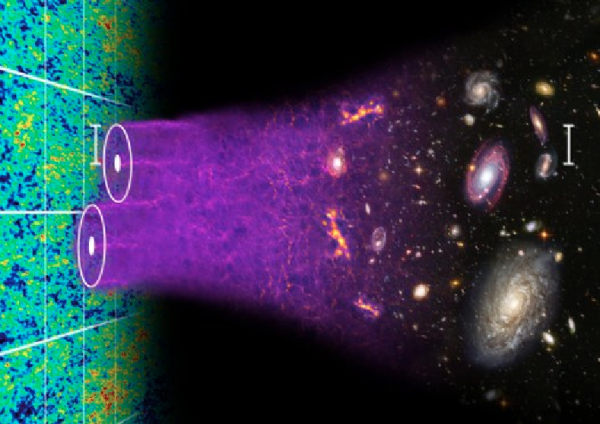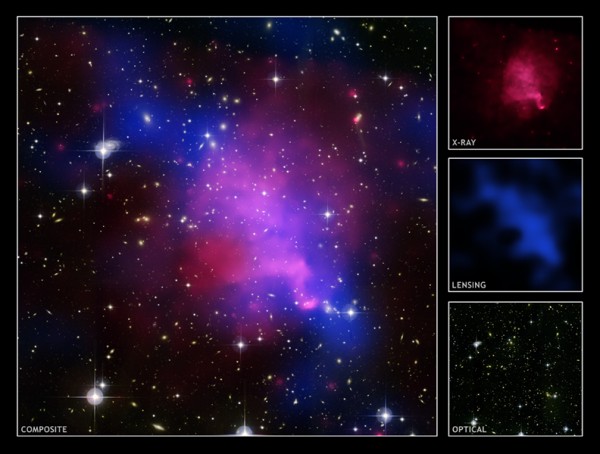“Science progresses best when observations force us to alter our preconceptions.” -Vera Rubin
Yesterday, we took an amazing look at a finding that looks like it rules out Dark Matter's #1 Competitor: TeVeS. But if that's true -- and the Universe must be full of dark matter -- just what exactly do we know about this mysterious substance?
 Image credit: Chris Blake and Sam Moorfield, via http://www.sdss3.org/surveys/boss.php.
Image credit: Chris Blake and Sam Moorfield, via http://www.sdss3.org/surveys/boss.php.
From how we know it's there, to how we know it's not normal matter, to what properties we can identify just from the indirect, astrophysical observations we can make, it's a rich and fascinating topic that we know an awful lot about!
Go and read the whole thing, and learn what we know (and how we know it) about dark matter!
- Log in to post comments


I thought that was a pretty good blog myself. It was informative, and it played a straight bat with ample caveats. Scientific. I liked this bit at the end:
"And we know what it isn’t: it isn’t baryonic (normal matter), it isn’t black holes, it isn’t photons, it isn’t fast-moving, hot stuff, and it probably isn’t simple, standard, cold and non-interacting stuff either, like most WIMP-type theories hope for".
And I especially liked the bit at the beginning, the bit that said this:
"Science progresses best when observations force us to alter our preconceptions"
Because we haven't observed any WIMPs, or any other dark-matter particles. So it's time the preconception of dark matter particles was altered. And people started paying attention to relativity, and spatial energy. Which can be inhomogeneous. And have a mass equivalence. And a gravitational effect.
Because space is dark, and there's a lot of it about.
The inflation model including dark matter is an ellegant theory. But it is in no ways a scientific argument pro dark matter as a solution today. That is because we adress exotic conditions: The Big Bang. The dark ages of de the universe. Before it wend transparant. Before the fotons wend free and wild. It is ok to bring in an actor that does not act with light.
Its like watching a Disney movie. It is totaly acceptable that the animals speak. Because the created worlds are exotic and would totaly not realistic without the speaking animals.
But. You can not assume that this actor, the dark matter, is still arround. Just like you do not assume that the universe is still dark. Where did it go ? It became e as in e=mc2. The chances that it is stil arround are 1 to c2. This shift from mass to energie is still gooing on. At some time the whole mass of the universe will be energy.
Nothing of this rejects the idee of dark matter. I just say that you cant use the fact that dark matter works well in the inflation model as an argument to make dark matter a fact in todays problem solutions. There are different lab conditions.
The galaxy rotation problem. If it is a problem at all. See. Zwicky can not fit in Kepler's Laws and Newtondynamics on large scales. Is that a suprise ? I would not think so. Neither of them obey to the Theory of relativity (on large scales).
I am sure we could create a dark mass too to explain the Mercurian relativistic perihelion. That would be pretty easy. But we did not. We used the leading and proven theory to solve the problem.
But. Lets assume ther is a problem. Let me ask then: are the rotations speeding up or speeding down? Dont say they are constant. Then you reject the birth of galaxys and the expanding model. If the speed is not constant, then dark matter can not be the solution. That should be very clear to you.
Then there is the concept. Dark matter does not interact with light? Now that is weird. Mass shapes spacetime. We know of gravital lenses. So, dark matter should show in relativistic beaming. Giving a solutions that does not obey to the relativistic theory is no solution.
Let us still assume that there is a problem. Then the problem must be translated to a relativistic language. Wat we have ? We have spacetime shaped by the galaxy embedded in spacetime shaped by the whole universe. The spacetime of the universe is expanding, thus getting flatter. The spacetime of the galaxy is getting flatter to, because a lot of the mass is shifting to energy, mostly photons. The space time shaped by the galaxy is 'deeper' at its bondarys, just like on earth the gravity is maximum on the surface. The spacetime shaped by the universe is at one side of the galaxy 'deeper' then on the other side, because the same reason. Now simulate that. And tell me: is the rotation of the galaxy speeding up or speeding down?
Just to be clear. I am not attacking you. Your voice of the community is very very apreciated. You are, as far as i know, not dark matter.
Would someone explain to me the significance of the Bullet Cluster. This is quoted often as the 'slam dunk' proof that Dark Matter exists, but I can't connect the dots. If 90% of the mass of the cluster is in the stellar material, then the gravity lensing is exactly where you'd expect it to be. If 90% of the mass of the cluster is in gas, then I see that you might have a problem. What I don't see is the 'slam dunk' evidence that 90% of the cluster (baryonic) mass is in the form of gas. Where is the obvious measurement of the gas content of this cluster (that isn't based on a ΛCDM model)?
"Where is the obvious measurement of the gas content of this cluster (that isn’t based on a ΛCDM model)?"
The material is luminescent. We can see the track. And the track of material is unaffected by mass outside the radius they sit at from the galactic CoG. Therefore we can use the motion there to determine that the mass in there is fairly close to the mass that is also visible. Far closer than the rotation speed of the outer limits and the globular cluster halo indicate is the case.
I don't know if that's what you're looking for, but your query is really not clear on what it is you're confused about.
John, “Science progresses best when observations force us to alter our preconceptions” doesn't mean "follow any old crap, as long as it's different".